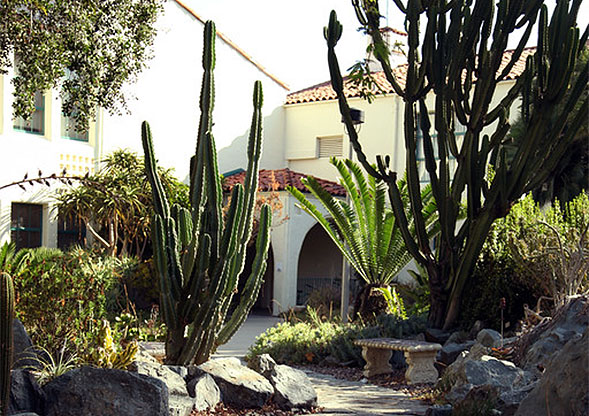Common Chords: Chapters in Aztec History
SDSU's Mediterranean Garden includes plants from five continents and gifts from three graduating classes.

This story appears in the fall 2015 issue of 360: The Magazine of San Diego State University.
Twenty years ago, there was no Mediterranean Garden on the San Diego State University campus. But despite its relatively recent birth, the garden grows thick with Aztec history.
Tucked into a rectangular space between the Physical Sciences and Life Sciences Buildings to the east and Hepner Hall to the west, the garden includes plants from five continents, gifts from three graduating classes and the labors of dozens of current and former Aztec faculty, staff and students.
This peaceful enclave, now a popular spot for meeting friends, eating lunch and taking a break between classes, was originally called the Freshman Quad. At its entry point—just west of the current Faculty-Staff Club—is the Hello Walkway, a nod to the once-popular Aztec tradition of having seniors formally welcome incoming freshmen and those same freshmen wish seniors farewell at graduation.
In the mid-1990s, three SDSU faculty members teamed up with staff in Facilities Services (formerly known as Physical Plant) to create a botanic display in the one-acre space. Professor Emerita Barbara Fredrich of the geography department; Professor Emeritus Pat Abbott of the geological sciences department and Michael Simpson, current professor of biology, led the project.
They decided to borrow from the original landscape plans for the campus, developed by Mark Daniels in collaboration with Howard Spencer Hazen, then the senior designer for the California State Division of Architecture. Hazen designed Hepner Hall, Hardy Memorial Tower, the Faculty-Staff Club (originally a café and bookstore), the Little Theatre and other early structures on Montezuma Mesa in the style known as Hispano/Moresque.
Complementing the architecture of these early buildings, Daniels envisioned planting drought-tolerant species from Southern Europe and North Africa. The Mediterranean Garden committee added flora from Chile, the South African Cape region, our own California and southern and southwestern Australia to the mix. These so-called Mediterranean ecosystems experience the same wet, mild winters and warm dry summers typical of San Diego.
Simpson and Abbott arranged for a fountain from Baja California—a gift from the senior class of 1997—while Facilities Services staff hauled a 1.5-ton block of granite to the garden from a quarry in nearby Mission Gorge. As work on the garden progressed, donations poured in from all corners of campus.
The Class of 1998 donated brick patios and tables. The Class of 1999 funded the South African rock garden and benches. Support also came from the Alpha Delta Pi sorority, the Department of Biology and the Colleges of Sciences and Arts and Letters.
As the garden committee envisioned, the Mediterranean Garden is not simply a beautiful sanctuary, but also an educational resource.
Simpson and his students have planted small vegetable gardens there, and they regularly harvest samples of the large diversity of plants to study in his courses on biodiversity, plant systematics and the taxonomy of California plants. In addition, several specimens from SDSU’s Mediterranean are part of the collection of the Consortium of California Herbaria based at the University of California, Berkeley.



